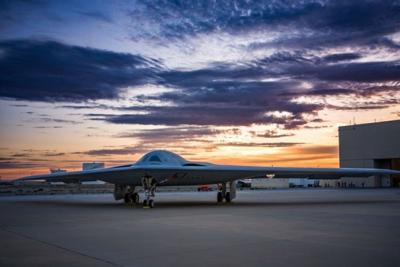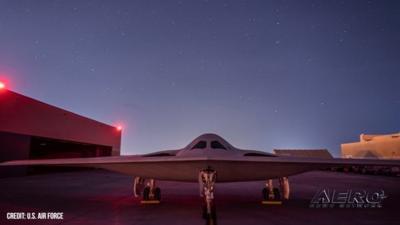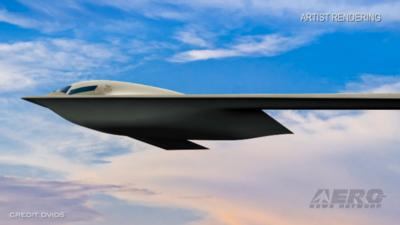Ground Engine Runs Underway at Palmdale
Personnel tasked with officiating the ground- and flight-testing campaigns salient to the DOD’s acceptance of the United States Air Force’s newest and most technologically-advanced, combat-capable stealth-bomber—Northrop-Grumman’s B-21 raider—have commenced engine runs at Northrop-Grumman’s Palmdale, California facility. So states the USAF.

Engine testing is an essential milestone in the maturation of any aircraft platform—military or civilian—and heralds the imminent entry into service of the world’s first sixth-generation tactical aircraft.
The B-21’s first flight remains a data-driven event, the date of which will be jointly determined by Northrop-Grumman and the United States Air Force.
Rolled out of Northrop Grumman’s Palmdale, California plant on 22 December 2022, the B-21 Raider long-range, intercontinental, stealth, strategic bomber—according to Pentagon officials—will function as the cornerstone of America’s deterrence capability for decades to come.
In a 29 November 2022 statement, Northrop Grumman confided: The bomber “has … been designed as the lead component of a larger family of systems that will deliver Intelligence, Surveillance and Reconnaissance (ISR), electronic attack and multi-domain networking capabilities.”
The statement confirmed suppositions that the B-21 will rely on external support platforms or systems; although whether these are escort aircraft, bomber-launched vehicles, satellites, or some other technology remains unclear. In recent months, USAF officials have described the B-21 as an ISR node deep within enemy-controlled airspace.

A senior Northrop Grumman official confirmed the B-21 will be “a lot stealthier” than the B-2 and feature improvements in maintainability and reliability conducive to its operating continuously in full stealth mode. By contrast, the B-2’s low-observable surfaces require many hundreds of man-hours of maintenance between missions. The B-21 further improves on the B-2 by eliminating the so-called special tape that covers the latter aircraft’s airframe seams and panel lines, the Northrop Grumman official concluded.
During a mid-March budget briefing, Department of the Air Force interim undersecretary Kristyn Jones revealed that Palmdale, California’s Air Force Plant 42 currently houses six B-21s in varying stages of production.
A Northrop Grumman spokesman stated: “To meet the evolving threat environment, the B-21 has been designed from day one for rapid upgradeability. Unlike earlier generation aircraft, the B-21 will not undergo block upgrades. New technology, capabilities, and weapons will be seamlessly incorporated through agile software upgrades and built-in hardware flexibility. This will ensure the B-21 Raider can continuously meet the evolving threat head on for decades to come.”
Referring to the Raider as a “digital bomber,” the Northrop Grumman spokesman added: “The B-21 uses agile software development, advanced manufacturing techniques, and digital engineering tools to help mitigate production risk” and “enable modern sustainment practices.”
Notwithstanding the persistence with which it is applied to the B-21, the term sixth-generation aircraft has yet to be clearly defined. Fifth-generation aircraft employ a high degree of stealth and sensor fusion for high degrees of situational awareness. How and to what extent sixth-generation aircraft might improve upon their forebears’ combat effectiveness remains to be seen.
Various descriptions of sixth generation being bandied about the defense industry suggest such aircraft would feature optionally manned capability—which the B-21 is meant to have—better situational awareness, better stealth, and the potential use of directed-energy weapons—among other possible attributes.

Of stealth, Northrop Grumman set forth that it is applying “continuously advancing technology, employing new manufacturing techniques and materials to ensure the B-21 will defeat the anti-access, area-denial systems it will face.”
Alluding to its work on the B-2 Spirit bomber, the YF-23 fighter prototype, the Tacit Blue stealth demonstrator and F-117 antecedent, the AGM-137 Tri-Service Standoff Missile, and presumed numerous additional classified programs, Northrop Grumman stated: “The B-21 benefits from more than three decades of strike and stealth technology. … It is the next evolution of the Air Force strategic bomber fleet, and a visible and flexible deterrent.”
Noting that the B-21’s Raider appellation commemorates Doolittle’s Raiders—a squadron of B-25 Mitchell medium bombers commanded by then Lieutenant Colonel James H. Doolittle which carried out America’s first WWII offensive operation against Imperial Japan, Northrop Grumman asserted: “The actions of those eighty volunteers were instrumental in shifting momentum in the Pacific theater.” The company posited the Doolittle Raid served as a “catalyst to a multitude [of future achievements] in U.S. air superiority from land or sea.”
 NTSB Prelim: Lee Aviation LLC JA30 SuperStol
NTSB Prelim: Lee Aviation LLC JA30 SuperStol Classic Aero-TV: Curtiss Jenny Build Wows AirVenture Crowds
Classic Aero-TV: Curtiss Jenny Build Wows AirVenture Crowds ANN's Daily Aero-Term (05.30.25): Very High Frequency (VHF)
ANN's Daily Aero-Term (05.30.25): Very High Frequency (VHF) Aero-News: Quote of the Day (05.30.25)
Aero-News: Quote of the Day (05.30.25) ANN's Daily Aero-Term (05.31.25): Microburst
ANN's Daily Aero-Term (05.31.25): Microburst





